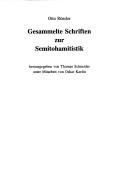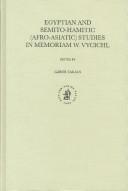| Listing 1 - 10 of 27 | << page >> |
Sort by
|
Book
ISSN: 05674980 ISBN: 9783447112819 3447112816 Year: 2019 Volume: 117 Publisher: Wiesbaden : Harrassowitz,
Abstract | Keywords | Export | Availability | Bookmark
 Loading...
Loading...Choose an application
- Reference Manager
- EndNote
- RefWorks (Direct export to RefWorks)
Die afroasiatische Suffixkonjugation ist ein finiter Verbalformtyp, der quer durch die meisten Sprachzweige der afroasiatischen Sprachen, zum Teil in hohem und funktionsreichem Aufkommen, zum Teil in verkümmerten Resten, seit der frühesten Bezeugung der afroasiatischen Sprachen in Form des Ägyptischen und der semitischen Sprachen im 3. Jahrtausend v.u.Z. bis heute in Verwendung ist. Je nach Fachbereich erscheint sie unter vielen Namen, von denen Perfekt, Pseudopartizip und Stativ die bekanntesten darstellen.
Afroasiatic languages --- Afrasian languages --- Afro-Asiatic languages --- Erythraic languages --- Hamito-Semitic languages --- Semito-Hamitic languages --- Verb
Book
ISBN: 1443864625 9781443864626 9781443840705 144384070X 1322051305 Year: 2012 Publisher: Newcastle upon Tyne, United Kingdom : Cambridge Scholars Publishing,
Abstract | Keywords | Export | Availability | Bookmark
 Loading...
Loading...Choose an application
- Reference Manager
- EndNote
- RefWorks (Direct export to RefWorks)
This refereed volume is a collection of selected scholarly articles resulting from research conducted for the first international Australian Workshop on Afro-Asiatic Linguistics (AWAAL), held on 11-13 September 2009 at the State Library of Queensland, Cultural Centre, Stanley Place, South Bank, Brisbane; as well as at the Great Court, the University of Queensland, St Lucia, Brisbane. The University of Queensland has been home to scholars and linguists such as Georges Perec, Eric Partridge and...
Afroasiatic languages --- Linguistics --- Afrasian languages --- Afro-Asiatic languages --- Erythraic languages --- Hamito-Semitic languages --- Semito-Hamitic languages
Book
ISBN: 1282413619 9786612413612 1443811432 9781443811439 9781443810029 1443810029 9781282413610 6612413611 Year: 2009 Publisher: Newcastle upon Tyne : Cambridge Scholars Pub.,
Abstract | Keywords | Export | Availability | Bookmark
 Loading...
Loading...Choose an application
- Reference Manager
- EndNote
- RefWorks (Direct export to RefWorks)
Robert Hetzron first organized the North American Conference on Afroasiatic Linguistics (NACAL) at the University of California, Santa Barbara in 1973 and passed away only six months after it had completed a quarter century of annual meetings. He would undoubtedly have been pleased to know that NACAL is still going strong, and that ten years after his passing it attracted no fewer than thirty-six scholars from the United States, Canada, and eight other countries, who presented on topics near ...
Book
ISBN: 8880981072 Year: 1999 Publisher: Padova : Unipress,
Abstract | Keywords | Export | Availability | Bookmark
 Loading...
Loading...Choose an application
- Reference Manager
- EndNote
- RefWorks (Direct export to RefWorks)
Afroasiatic languages --- Langues chamito-sémitiques --- Congresses. --- Congrès --- Conferences - Meetings --- Langues chamito-sémitiques --- Congrès --- Afrasian languages --- Afro-Asiatic languages --- Erythraic languages --- Hamito-Semitic languages --- Semito-Hamitic languages
Periodical
Abstract | Keywords | Export | Availability | Bookmark
 Loading...
Loading...Choose an application
- Reference Manager
- EndNote
- RefWorks (Direct export to RefWorks)
Book
ISBN: 9789027200129 9789027264572 9027264570 9027200122 Year: 2018 Publisher: Amsterdam ; Philadelphia : John Benjamins Publishing Company,
Abstract | Keywords | Export | Availability | Bookmark
 Loading...
Loading...Choose an application
- Reference Manager
- EndNote
- RefWorks (Direct export to RefWorks)
Book
ISBN: 2902709668 9782902709663 Year: 1991 Publisher: Grenoble : Ellug,
Abstract | Keywords | Export | Availability | Bookmark
 Loading...
Loading...Choose an application
- Reference Manager
- EndNote
- RefWorks (Direct export to RefWorks)
African languages --- Grammar --- Langues africaines --- Syntax --- Syntaxe --- Niger-Congo languages --- Nilo-Saharan languages --- Afroasiatic languages --- Syntax. --- -Nilo-Saharan languages --- -Afroasiatic languages --- -Afrasian languages --- Afro-Asiatic languages --- Erythraic languages --- Hamito-Semitic languages --- Semito-Hamitic languages --- -Syntax --- Afrasian languages --- Niger-Congo languages - Syntax. --- Nilo-Saharan languages - Syntax. --- Afroasiatic languages - Syntax.

ISBN: 3934628133 Year: 2001 Volume: 287 Publisher: Münster : Ugarit,
Abstract | Keywords | Export | Availability | Bookmark
 Loading...
Loading...Choose an application
- Reference Manager
- EndNote
- RefWorks (Direct export to RefWorks)
Afroasiatic languages --- Semitic languages --- Hamitic languages --- Langues chamito-sémitiques --- Langues sémitiques --- Langues chamitiques --- -Hamitic languages --- -Semitic languages --- -Afroasiatic languages --- Afrasian languages --- Afro-Asiatic languages --- Erythraic languages --- Hamito-Semitic languages --- Semito-Hamitic languages --- Grammar, Comparative --- -Grammar, Comparative --- Langues chamito-sémitiques --- Langues sémitiques --- -Afrasian languages
Book
ISBN: 9780521865333 9781139423649 1139423649 1280773707 9781280773709 9781139419550 1139419552 0521865336 1139411217 1316089118 9786613684479 113942257X 1139417509 1139421603 1139020935 9781139020930 9781139411219 9781316089118 6613684473 9781139417501 9781139421607 1108977855 Year: 2012 Publisher: Cambridge : Cambridge University Press,
Abstract | Keywords | Export | Availability | Bookmark
 Loading...
Loading...Choose an application
- Reference Manager
- EndNote
- RefWorks (Direct export to RefWorks)
The first typological study of Afroasiatic languages. Afroasiatic languages are spoken by some 300 million people in Northern, Central and Eastern Africa and the Middle East. This book is the first typological study of these languages, which are comprised of around 375 living and extinct varieties. They are an important object of study because of their typological diversity in the areas of phonology (some have tone; others do not), morphology (some have extensive inflectional systems; others do not), position of the verb in the clause (some are verb-initial, some are verb-medial, and some are verb-final) and in the semantic functions they encode. This book documents this typological diversity and the typological similarities across the languages and includes information on endangered and little-known languages. Requiring no previous knowledge of the specific language families, it will be welcomed by linguists interested in linguistic theory, typology, historical linguistics and endangered languages, as well as scholars of Africa and the Middle East.
African languages --- Asian languages --- Afroasiatic languages. --- Langues chamito-sémitiques --- Langues chamito-sémitiques --- Language surveys. --- Language and languages --- Linguistic surveys --- Linguistic geography --- Surveys --- Afrasian languages --- Afro-Asiatic languages --- Erythraic languages --- Hamito-Semitic languages --- Semito-Hamitic languages

ISBN: 9004132457 9789004132450 9047412230 9789047412236 Year: 2004 Volume: 39 Publisher: Leiden ;Boston Brill
Abstract | Keywords | Export | Availability | Bookmark
 Loading...
Loading...Choose an application
- Reference Manager
- EndNote
- RefWorks (Direct export to RefWorks)
This volume is paying homage to the memory of Werner Vycichl (1909-1999), one of the most outstanding figures of Semito-Hamitic (Afro-Asiatic) comparative linguistics. The contributions by well-known specialists comprise almost all principle branches of the Semito-Hamitic macrofamily. The volume is divided in five major sections following the areas of interest of W. Vycichl: Egyptology and Coptology, Semitic linguistics, Beja (Northern Cushitic), Chadic, and general Semito-Hamitic (Afro-Asiatic) comparative linguistics (Berber has been excluded, since we already have a separate Mémorial Werner Vycichl with articles only in Berberology). The volume is important for the researchers in all the linguistic fields enumerated above as well as for those interested in African or comparative linguistics in general.
Afroasiatic languages. --- Egyptian philology. --- Langues chamito-sémitiques --- Philologie égyptienne --- Langues chamito-sémitiques --- Philologie égyptienne --- Afroasiatic languages --- Egyptian philology --- Afrasian languages --- Afro-Asiatic languages --- Erythraic languages --- Hamito-Semitic languages --- Semito-Hamitic languages
| Listing 1 - 10 of 27 | << page >> |
Sort by
|

 Search
Search Feedback
Feedback About UniCat
About UniCat  Help
Help News
News